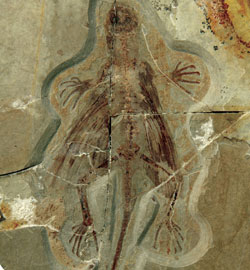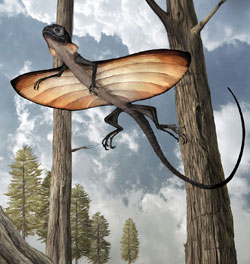Prehistoric lizard glided through air using ribs
Prehistoric lizard glided through air using ribs
mongabay.com
March 19, 2007
An extinct species of lizard used a wing-like membrane supported by the animal’s elongated ribs for gliding through the air according to Chinese researchers.

|
The 6-inch (15.5 cm) lizard, found in the Liaoning Province of northeastern China, lived during the Early Cretaceous period. The specimen is described in the early online edition of the journal Proceedings of the National Academy of Sciences (PNAS).
The scientists say the finding is significant because it is an example of convergent evolution of gliding in lizards. Draco lizards which exist today in southeast Asia use a similar mechanism for gliding. A southeast Asian snake species also employs a similar structure for gliding.
“Most other animals with the ability to glide, such as “flying” frogs and squirrels, use a membrane spread between their toes, or between their body and legs, to catch air and stay airborne,” explained a release from PNAS. “The most striking feature of Xianglong is its eight elongated ribs that helped to spread a wing-like membrane to the left and right of the lizard’s body.”
The ancient species is dubbed Xianglong zhaoi
Liaoning Province of northeastern China is famous for its well-preserved fossils. Since the early 1990s, remain from dozens of previously unknown species have been uncovered from fossil sites near the small village of Sihetun, creating fossil industry that provides employment for villagers.
CITATION: Pi-peng Li, Ke-Qin Gao, Lianhai Hou, and Xing Xu (2007). A gliding lizard from the Early Cretaceous of China. PNAS Online Early Edition for the week of March 19-23 , 2007
